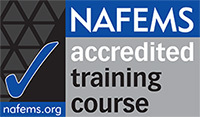How are residual stresses caused by welding in metals simulated and used in practical engineering applications?
What are the difficulties and challenges of using FE software to simulate welding?
What are the potential errors and limitations of the FE solutions in predicting residual stresses caused by welding?
This course gives you practical advice with a minimum of theory.
Metals Material Modelling: Welding Simulation and Residual Stresses
This e-learning course is aimed at engineers and designers who want to become familiar with how the Finite Element method can be used to simulate the welding process in metals and the residual stresses arising from welding.
The course will cover the finite element modelling of the welding of metallic structures using filler material where the high temperatures experienced by the materials during welding generate thermo-mechanical stresses and microstructural changes. Finite element solutions for the post-weld residual stresses will be discussed and compared to experimental measurements.
Difficulties encountered by the finite element user and the limitations of finite element software in modelling the welding process will be highlighted using examples to demonstrate the mechanics of welding and the expected accuracy of the finite element solutions.
The pre-requisite for this course is a working knowledge of linear finite element theory and applications. No prior knowledge of Welding is required. The course is independent of any finite element software code.
The objectives of this course are:
- To provide delegates with a good understanding of the welding process used in industry to join two metallic structures
- To highlight the difficulties, limitations and sources of error that may be encountered in modelling welding and the post-weld residual stresses
- To present examples of practical welding problems and highlight the validation of the finite element solutions
Why an e-learning class?
Travel and training budgets are always tight! The e-learning course has been developed to help you meet your training needs.
If your company has a group of engineers, or specific training requirements across any subjects, please contact us to discuss options.
Course Program
This is a three-week live web-based eLearning course with a total of 6 hours of tuition (presented as a two-hour session per week). Delegates will be provided with copies of all lecture slides including many self-test problems (with worked solutions).
Session 1
Introduction to Welding
- About Metals
- Welding Processes
- Types of Welding Joints
- Material Zones in Welds
- Distortions in Welding
- Weld Defects and Cracks
Analysis of welding
- Modelling Welding- Knowledge Required
- Plasticity Analysis
- Thermal Analysis
- Metallurgical Analysis
- Creep Analysis
Self-test questions 1 (optional homework)- Questions to reinforce the topics covered in the lectures
Session 2
Residual Stresses
- About Residual Stresses
- Residual stresses in welds
- Post Weld Heat Treatment (PWHT)
- Measurement of Residual Stresses
Computational Modelling of Welding
- Thermal, Mechanical and Metallurgical Interactions
- Material Properties Required for Modelling Welding
- Modelling Thermo-Mechanical Problems
- Modelling Welding Heat Source
- Modelling Phase Transformations
Solutions to self-test questions 1 (Full solutions highlighting the key aspects)
Self-test questions 2 (optional homework)- Questions to reinforce the topics covered in the lectures
Session 3
FE Simulation of Welding
- Modelling Material Non-linearity
- Modelling Time Marching
- Modelling Filler Deposition in Welding
- Challenges in Simulating Welding Problems
Welding and Residual Stresses Case Studies
- Case Study 1- Welding Thin Sections
- Case Study 2- Dissimilar Welds in Thick Pipes
Summary of key points, tips and guidelines
Solutions to self-test questions 2
Feedback from former e-Learning students:
"Super! Doesn't get better than this. Good idea to start having e-Learning courses."
R.P.
"I'm really happy not to pay a big fraction of my annual training budget to airlines and hotels. A BIG plus to e-learning."
V.G.





